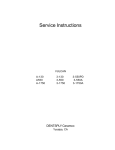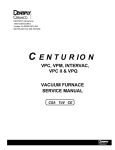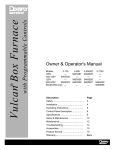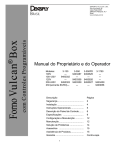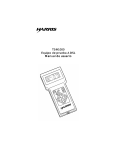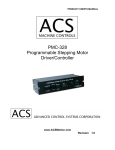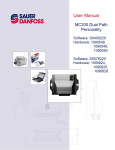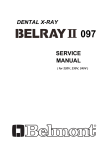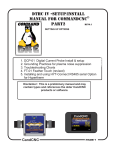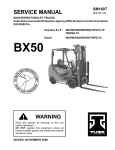Download DENTSPLY Vulcan Box A-130 Service manual
Transcript
Vulcan® Furnace Service Manual Models: A-130 A550 A-1750 3-130 3-550 3-1750 3-550PD 3-550A 3-1750A CERAMCO ® SAFETY SAFETY FIRST • Don’t bypass the power cord’s ground lead with two-wire extension cords or plug adaptors. • Don’t disconnect green/yellow safety-earth ground wire that connects the ground lug of the power receptacle to the chassis ground. • Don’t plug in the power cord until directed by the installation instructions. • Don’t repair the furnace unless you are a qualified technician and know how to work with hazardous voltages. • Don’t locate and operate the furnace in close proximity to combustible materials. • Observe all WARNING statements. They point out situations that can cause injury or equipment damage. • Disconnect the power cord before attempting to service. • It is the user’s responsibility to use only cleaning agents and materials that will not result in hazards to the equipment or material contained within. • When replacing the main power supply cord use only a direct equivalent high-temperature cable. • When replacing the main fuse use only a direct equivalent. TABLE OF CONTENTS SECTION 1 CIRCUIT DESCRIPTION 1.1 1.2 1.2.1 1.2.2 1.2.3 1.2.4 A-CONTROL INTRODUCTION ..........................................1-1 CIRCUIT DESCRIPTION ..............................1-1 Analog Meter Readout ...............................1-1 Front Panel Controls ..................................1-1 Muffle Control ...........................................1-1 Power Supply ............................................1-1 SECTION 2 TROUBLESHOOTING 2.1 2.2 2.3 2.3.1 2.3.2 2.3.3 2.4 2.5 2.6 2.7 2.8 5.3.3 5.3.4 5.3.5 5.3.6 5.3.7 5.4 5.5 5.6 5.7 5.8 5.9 Peripheral Drive ........................................5-1 Motor Drive ...............................................5-1 Analog Circuitry.........................................5-1 Display Board ...........................................5-1 Fan Drive Control ......................................5-2 TROUBLESHOOTING COMPONENTS............5-2 ERROR CODES...........................................5-3 DIAGNOSTIC TABLES .................................5-4 BLOCK DIAGRAM.......................................5-8 SCHEMATICS ............................................5-9 WIRING DIAGRAM ....................................5-12 A-CONTROL FACTORY REPAIR........................................2-1 BEFORE YOU START ...................................2-1 TROUBLESHOOTING GUIDES ......................2-1 Power Supply ............................................2-1 Analog Circuitry.........................................2-1 Triac Drive.................................................2-1 TROUBLESHOOTING COMPONENTS ............2-1 BLOCK DIAGRAM.......................................2-3 SCHEMATIC ..............................................2-4 CONTROL CIRCUIT BOARD..........................2-5 WIRING DIAGRAM .....................................2-6 SECTION 6 ADJUSTMENT/CALIBRATION3-STAGE 6.1 6.2 6.3 6.3.1 6.3.2 6.4 6.4.1 6.4.2 SCOPE .....................................................6-1 FACTORY REPAIR .......................................6-1 ADJUSTMENT/CALIBRATION .......................6-1 Temperature ............................................6-1 Door, Lift Drag Adjustment ........................6-1 CIRCUIT BOARD CALIBRATION ...................6-1 Required Test Equipment ..........................6-1 Temperature .............................................6-1 SECTION 7 SERVICE PARTS SECTION 3 CALIBRATION 3.1 3.2 3.3 3.3.1 3.4 3.4.1 3.4.2 A-CONTROL SCOPE ......................................................3-1 FACTORY REPAIR........................................3-1 ADJUSTMENTS...........................................3-1 Door, Lift Drag Adjustment ........................3-1 CIRCUIT BOARD CALIBRATION ...................3-1 Required Test Equipment ..........................3-1 Temperature .............................................3-1 SECTION 4 CIRCUIT DESCRIPTION 4.1 4.2 4.2.1 4.2.2 4.2.3 4.2.4 4.2.5 4.2.6 3-STAGE INTRODUCTION CIRCUIT DESCRIPTION .............................4-1 LCD Display Readout.................................4-1 Front Panel Control ...................................4-1 Muffle Control...........................................4-1 Power Supply............................................4-1 Motor Drive Control ...................................4-1 Fan Drive Control ......................................4-1 SECTION 5 TROUBLESHOOTING 5.1 5.2 5.2.1 5.3 5.3.1 5.3.2 3-STAGE FACTORY REPAIR........................................5-1 BEFORE YOU START ...................................5-1 Isolating a Problem ...................................5-1 TROUBLESHOOTING GUIDES .....................5-1 Power Supply ............................................5-1 Microprocessor ........................................5-1 7.1 7.2 7.3 7.4 7.5 7.6 7.7 7.8 ORDERING INSTRUCTIONS.........................7-1 MUFFLE AND THERMOCOUPLE ...................7-1 MUFFLE (3-550 PD / AIR EXCH)...................7-2 CABINET PARTS.........................................7-3 DOOR PARTS ............................................7-4 A-CONTROLLER PARTS ..............................7-5 3-STAGE & 3-550 CONTROLLER PARTS........7-6 LIFT MECHANISM PARTS (3-550PD) ............7-7 SECTION 8 DISASSEMBLY/REASSEMBLY 8.1 8.2 8.3 8.4 8.5 8.6 8.7 8.8 8.9 8.10 8.11 8.12 8.13 8.14 8.15 CONTROL DRAWER REMOVAL.....................8-1 TRIAC........................................................8-1 MEMBRANE SWITCH..................................8-2 DISPLAY PCB ............................................8-3 A-CONTROL PCB .......................................8-4 3 STAGE CONTROL PCB .............................8-5 DOOR ASSEMBLY/ADJUSTMENT ................8-6 HEATING PLATES.......................................8-7 MUFFLE REPLACEMENT........................ .....8-8 THERMOCOUPLE (A-Control) .....................8-9 THERMOCOUPLE (3 STAGE) .......................8-9 MUFFLE REPLACEMENT(3-550 PD)........ ....8-10 THERMOCOUPLE (3-550PD) ......................8-11 POWER SWITCH .......................................8-12 POWER DOOR REPLACEMENT ...................8-13 SECTION 1 - CIRCUIT DESCRIPTION - A-CONTROL 1.1 INTRODUCTION The purpose of this section is to familiarize the user or service personnel with the circuit level operation of the VULCAN. This knowledge is necessary to aid in troubleshooting of a unit's failure and may also allow the user to gain greater insight into the VULCAN’s versatility for particular applications. A detailed description is given for the following circuit functions: • • • • Analog Meter Readout Front Panel Controls Muffle Control Power Supply To slow down the heatup time of the muffle (RP2 set clockwise and muffle is at low temperature) a rate control potentiometer (RP3) has been added to the circuitry. A sawtooth signal from pin2 of U2 is compared with a fixed reference voltage which can be set by RP3. As the sawtooth voltage exceeds the value of the fixed reference voltage, amplifier U3 produces a negative output which in turn increases the thermocouple signal output from U1 and Vpin3 of U2 and is now more negative than Vref, thus the triac output pulses stop. 1.2.4 POWER SUPPLY The rectified supply current (D2) is zener regulated to 8.6V and biased by dropping resistors R11, R12. The positive voltage to U1 and U2 is provided by a 6.8V zener diode D1. 1.2 CIRCUIT DESCRIPTION 1.2.1 ANALOG METER READOUT NOTES: The Type K thermocouple which extends from the back of the muffle is directly connected to an analog meter which provides the operator with the present muffle temperature. The yellow lead of the thermocouple is connected to the + input of the meter. ________________________________________________ ________________________________________________ ________________________________________________ 1.2.2 FRONT PANEL CONTROLS The power on/off switch provides AC line voltage to the furnace if the door switch is closed, while the setpoint potentiometer (10K) provides the electronics with a reference voltage which determines the final muffle temperature. ________________________________________________ ________________________________________________ ________________________________________________ 1.2.3 MUFFLE CONTROL The muffle is controlled by means of a triac. This muffle triac may be activated anytime when the AC cycle goes through zero, and once activated it will only be opened again when the AC sine wave passes through 0 volts.The triac is controlled by a Zero Voltage Switch (integrated circuit U2) and is configured as a proportional controller.Trigger pulses are generated when the comparator detects Vpin3 is above the Vref. The sensed temperature from the amplified thermocouple signal is then lower than the set value of RP2. As Vpin3 is near in value of Vref, a proportional control takes over, i. e. power is delivered by bursts to the load. ________________________________________________ ________________________________________________ ________________________________________________ ________________________________________________ ________________________________________________ ________________________________________________ ________________________________________________ ________________________________________________ I ________________________________________________ ________________________________________________ t T Load Current - Proportional Control ________________________________________________ ________________________________________________ 1–1 SECTION 2 - TROUBLESHOOTING - A-CONTROL 2.3.3 TRIAC DRIVE 2.1 FACTORY REPAIR A current pulse from U2 pin 6 of about 60mA will turn on the gate of the muffle triac which in turn will then carry the full load current. The voltage across the triac is now at 1-2 Vac. In order to comply with norms limiting the frequency at which a kW size load may be connected to the main line (fluorescent tubes "flickering") a proportional temperature control is provided by means of burst firing the triac. DENTSPLY Ceramco maintains a factory repair department for those customers not possessing the necessary personnel or test equipment to maintain the VULCAN. If a unit is returned to the factory for calibration or repair, a detailed description of the specific problem should be attached to minimize turnaround time. Call factory for PR number before shipping at 1-800-835-6639. NOTES: 2.2 BEFORE YOU START Since no troubleshooting guide can possibly cover all the potential problems, the aim of this guide is to give a methodology which, if applied consistently, will lead to the problem area. Therefore , it is necessary to familiarize yourself with the VULCAN by reviewing the functional description in conjunction with the schematic. Successful troubleshooting depends upon understanding the circuit operation. ________________________________________________ ________________________________________________ ________________________________________________ ________________________________________________ ________________________________________________ WARNING: With covers removed, dangerous voltage points may be exposed. Contact with any of these points could cause serious injury. 2.4 TROUBLESHOOTING COMPONENTS 2.4.1 DIODE 2.3 TROUBLESHOOTING GUIDES A diode (except a zener) is defective if there is greater than 1 Vdc (typically 0.7 Vdc) forward voltage across it. WARNING: When measuring voltages use battery operated test equipment unless an isolation transformer is connected between circuit input and AC line. 2.4.2 OPERATIONAL AMPLIFIER Rectifier diodes D2 and D3 convert the AC line voltage to a DC voltage, while resistors R11, R12 reduce the current flow thru the 8.6V internal zener diode of U2 and the 6.8V external zener diode D1. Capacitors C1 and C5 filter the rectified voltages. Most of the circuit's current consumption is taken up by the triac gate drive. Generally, the “+” and “-” inputs of an operational amplifier will have less than 15 mV voltage difference when operating under normal conditions. If the output voltage stays at maximum positive (typically 1/3 of the supply voltage), the “+” input voltage should be more positive than the “-” input voltage. If the output voltage stays at minimum (typically 1-5 mV), the “-” input voltage should be more positive than the “+” input voltage. 2.3.2 ANALOG CIRCUITRY 2.4.3 TRIAC The thermocouple voltage which ranges from 0-45mV (25°C - 1100°C) is multiplied by amplifier U1 approximately 100 times (depending on the setting of potentiometer RP1) and added to the negative setpoint voltage from RP2. A sawtooth voltage signal is generated by U2 from a constant current source charging capacitor C4. The value of C4 determines the burst period of the triac output (typically 8 seconds). The triac gate output pulse current is about 60mA. The triac is triggered in quadrants II and III. Synchronization is provided by resistor R10. Its value determines the trigger pulse length. The gate to power line return voltage under load measures typically 1-2 Vac, while the MT2 to return voltage measures between 1.3-1.8 Vac. A triac without connections and no power applied can be checked for a go-no go condition with an ohmmeter. The gate to MT1 resistance for a power triac (20-40A) should be between 50 and 100 ohms; there should be infinite resistance between MT1 and MT2. 2.3.1 POWER SUPPLY 2.4.4 CAPACITOR Shorted capacitors have 0V across their terminals. Open capacitors can be located by using a good capacitor connected in parallel with the capacitor under test and observing the resulting effect. 2–1 SECTION 2 - TROUBLESHOOTING - A-CONTROL Leaking capacitors will often have a decreased voltage across their terminals. NOTES: ________________________________________________ ________________________________________________ ________________________________________________ ________________________________________________ ________________________________________________ 2–2 SECTION 2 - TROUBLESHOOTING - A-CONTROL 2.5 BLOCK DIAGRAM 120/240V 60/50Hz Line Power Supply D1,C1,R11 Return Cabinet +6.8V -8.6V Set Point Pot Comparator, Power Supply, Triac Driver U2 Rate Control Pot Amplifier U1 Thermocouple Power Triac 25A, 400V Feedback Muffle 2–3 SECTION 2 - TROUBLESHOOTING - A-CONTROL 2.6 SCHEMATIC 2–4 SECTION 2 - TROUBLESHOOTING - A-CONTROL 2.7 CONTROL CIRCUIT BOARD Rate Control Temperature Meter Connection Triac Gate Muffle Connections Setpoint Potentiometer Thermocouple Amplifier Proportional Control iC 2–5 SECTION 2 - TROUBLESHOOTING - A-CONTROL 2.8 WIRING DIAGRAM 230V LINE CORD 230V RECEPTACLE NOTE: A1750 - 250V,20A LINE CORD WHT WHT 120V LINE CORD GRN/YELL BLK CABINET GND 230V A-1750 230V HOOK UP HEATING PLATE RIAC HEATSINK C P1 120V HOOK UP AND 1750 MUFFLE TRIAC D DOOR SAFETY SWITCH P6 WHT BLK WHT CONTROL DRAWER GND RED TAN GRN/YELL P1 P5 ROUTE ALL MUFFLE WIRES THRU HERE AC1 THERMOCOUPLE AC2 MT2 MT1 WHT/BLK A BLK B TOP TERMINALS ORN GATE A B RED YELL POWER SWITCH SETPOINT ADJUST C D ANALOG PANEL METER RELAY FOR A-1750 ONLY 2–6 A B SECTION 3 - ADJUSTMENT/CALIBRATION - A-CONTROL 3.1 SCOPE 3.4 CIRCUIT BOARD CALIBRATION This section gives the procedures to be used for the calibration and specification verification of the VULCAN. The furnace specifications are given in the Owner & Operator’s Manual. Calibration of the VULCAN circuit board is performed in one single step. 3.4.1 REQUIRED TEST EQUIPMENT - Multimeter - Pot adjustment tool 3.2 FACTORY REPAIR WARNING With control drawer opened, dangerous voltage points may be exposed. Contact with any of these points could cause serious injury. DENTSPLY Ceramco maintains a factory repair department for those customers not possessing the necessary personnel or test equipment to maintain the VULCAN. If a unit is returned to the factory for calibration or repair, a detailed description of the specific problem should be included to minimize turnaround time. Call factory for RMA number before shipping at 909-.795.2461. 3.4.2 TEMPERATURE Disconnect the power cord from the wall outlet and open the control drawer. Connect the black lead of the ohmmeter to the red thermocouple connection on temperature meter. Touch the red lead of the ohmmeter to the leg with a circle on R13. Adjust RP1 to read 1060 ohms on the ohmmeter. 3.3 ADJUSTMENTS 3.3.1 DOOR, LIFT DRAG ADJUSTMENT The lift drag force is controlled by a set of friction washers on each of the upper pivot arms. If the drag becomes too stiff (too hard to open and close furnace) or too loose an adjustment can be made using the following procedure: On models A-550 rated at 120V the potentiometer RP3 should be adjusted the following way: Touch the black lead of the ohmmeter to pin 3 of U3 and the red lead to the leg of R14, see figure 7.2. Adjust RP3 to read between 19 and 20 Kohm on the ohmmeter. This adjustment limits the amount of current going thru the muffle by about 15% in order to comply with safety agency rulings. For all other models RP3 should be fully clockwise. TOOLS: 5/32" Allen Wrench - Turn the allen head screws on the upper side of the furnace either clockwise to tighten or counterclockwise to loosen the drag force. NOTE: Equal adjustment should be made on each side. Turn screws only 1/6 of a revolution at a time when making adjustment. Connect DMM to PCB as shown in Figure 7-2: a. For all 120V Units: Adjust RP# to read 19K-20K Ohms b. For all 220V-240V Units: Adjust RP3 Fully Clockwise (CW) Black Lead to U3 Pin 3 Here Front of Control Drawer As an alternate circuit board calibration, without the use of an ohmmeter, bring the furnace temperature to the desired level. At steady state temperature insert a thermocouple, connected to a temperature monitor, into the exhaust opening of the furnace and after stabilization read the muffle temperature. Compare this reading with the temperature meter reading of the furnace. In several steps adjust RP1 to obtain equal readings. Allow ample time between adjustment steps since only a few watts are added/subtracted which each adjustment of RP1. Red Lead to R14 Here Figure 7-2 3–1 SECTION 4 - CIRCUIT DESCRIPTION - 3-STAGE 4.2.4 POWER SUPPLY 4.1 INTRODUCTION The purpose of this section is to familiarize the user or service personnel with the circuit level operation of the VULCAN. This knowledge is necessary to aid in troubleshooting of a unit's failure and may also allow the user to gain greater insight into the VULCAN’s versatility for particular applications. A detailed description is given for the following circuit functions: * Display Readout * Front Panel Control * Muffle Control * Power Supply * Motor Drive Control (option for 3-Stage) *Temperature Measurement One DC power supply voltage is generated on the control circuit board +5V. 4.2.4.1 +12V SUPPLY The +12 VDC is generated from 15 watt switching power supply mounted onto the main control PC board. 4.2.4.2 +5V SUPPLY Refer to schematic, page 5-9. DC voltage from the output of the switching power supply is used by the +5V linear regulator U3 to generate the +5V. The capacitor C21 provides additional filtering. The 1.23V reference diode D1 generate their outputs from this supply. 4.2.5 MOTOR DRIVE CONTROL (3-550 PD) The +12VDC motor which moves the door vertically is controlled by a 16 pin motor controller/driver I.C. This I.C. provides all necessary functions for a complete closed loop system. A two wire cable connects the motor to the 1 Amp H-bridge switch on the I.C. The microprocessor (U9) activates the H-switch through two input pins. If both are low the motor will turn in one direction, if both are high the motor turns in the opposite direction. A third pin sends a signal from the motor controller/driver I.C. to the microprocessor when the motor has stalled (up or down position). The muffle temperature is derived from a Thermocouple (type "K") which generates an output voltage of up to 50mV. This feedback signal is then manipulated by the electronics to control the muffle temperature. 4.2 CIRCUIT DESCRIPTION 3-STAGE 4.2.1 LCD DISPLAY READOUT The display board converts serial data from the microprocessor to 8-bit parallel data. Each byte transferred is either a command or a data byte depending on the state of the two control bits RS and E (DIS ENA). The 16 character LCD module is controlled by the microprocessor via its Serial Peripheral Interface (SPI) port. The display is updated every 0.5 sec or when a corresponding front panel key has been activated. 4.2.6 FAN DRIVE CONTROL 3-550A/1750A The air exchange fan is controlled by means of the front panel membrane switch. Speed selections are from 0 - 9 (0 is off and 9 is highest speed). Speed 1 selection changes the air in the muffle twice a minute. 4.2.2 FRONT PANEL CONTROL NOTES: The power on/off switch switches the AC line voltage. The membrane switches are arranged in a 8x4 matrix. The microprocessor scans the entire matrix every 50 msec by setting one column at a time to a logic 0 and then reading the rows. Once a contact closure has been detected this value is stored. ________________________________________________ ________________________________________________ ________________________________________________ 4.2.3 MUFFLE CONTROL The microprocessor (U9) sends a serial digital signal to an octal peripheral driver (U6) which in turn converts and latches it to parallel data. This data is then used to drive several peripheral devices. U9 is connected to an opto isolator (U7). The isolator's output is connected to the gate of the muffle triac. The muffle triac may be activated anytime during an AC cycle, but once activated it can only be opened when the AC sine wave passes through 0 volts. U9 accesses U7 0.5 msec before zero crossing to turn the triac off. At this time a value calculated by the control routine determines how much time should elapse before the triac is turned on again. ________________________________________________ 4–1 SECTION 5 - TROUBLESHOOTING - 3-STAGE 5.1 FACTORY REPAIR 5.3 TROUBLESHOOTING GUIDES DENTSPLY Ceramco maintains a factory repair department for those customers not possessing the necessary personnel or test equipment to maintain the VULCAN. If a unit is returned to the factory for calibration or repair, a detailed description of the specific problem should be attached to minimize turnaround time. Call factory for PR number before shipping at 1-800-835-6639. 5.3.1 POWER SUPPLY 5.2 BEFORE YOU START Since no troubleshooting guide can possibly cover all the potential problems, the aim of this guide is to give a methodology which, if applied consistently, will lead to the problem area. Therefore , it is necessary to familiarize yourself with the VULCAN by reviewing the functional description and the detailed circuit description (Section 4) in conjunction with the schematics (Section 5). Successful troubleshooting depends upon understanding the circuit operation within each functional block as well as the block relationships. WARNING With covers removed, dangerous voltage points may be exposed. Contact with any of these points could cause serious injury. To determine a faulty power supply use the table on page 5-3. To troubleshoot a faulty power supply use the procedures listed on page 5-4. If the desired results are obtained in each of the steps in the tables, replace D43, U9 or U7 as appropriate. 5.3.2 MICROPROCESSOR Generally, when the furnace is totally nonfunctional, i.e., display is unintelligible, no display, random relay clicking, no key response, or the front panel LED’s stay on at power up, the problem is in the microprocessor section. However, before troubleshooting this section, check the appropriate dedicated circuits for correct operation. Detailed reading of the circuit description is also very important. See page 5-5 to troubleshoot the microprocessor. 5.3.3 PERIPHERAL DRIVE The peripheral driver U6 is accessed at every line voltage zero crossing by the microprocessor. The logic state of the eight output drivers, Y0 -Y7, is latched into the shift register at time t0 on the high to low transition of SIOE. Input data present at the SI input is clocked into the shift register on the high to low transition of SCLK. See page 5-6 to troubleshoot the peripheral driver. The intent of this section is to provide the information to return the VULCAN to proper operation. Information is divided into two parts. Part one contains the overall furnace troubleshooting block diagram which is useful in isolating defective blocks within the furnace. Part two consists of a series of circuit guides , one for each block shown in the block diagram, that provides settings and measurements for troubleshooting an individual block. Also, each circuit guide references related schematics and circuit descriptions. Inspect the components, wiring and circuit boards of the VULCAN for damage. Finally, ensure that the fuses are intact and the internal power supplies are good. 5.3.4 MOTOR DRIVE (OPTIONAL ACCESSORY) 5.2.1 ISOLATING A PROBLEM 5.3.6 DISPLAY BOARD To successfully troubleshoot this furnace, the symptoms must first be identified, the faulty block isolated, then analyzed, and finally the defective component located and replaced. After the block is isolated, refer to the appropriate functional circuit guide. The motor driver U8 is accessed by the microprocessor to lift or lower the door. U8 provides a feedback to the microprocessor to indicate an overcurrent condition which is set at approximately 1.00Amp by resistor R3. See page 5-6 to troubleshoot the motor driver. 5.3.5 ANALOG CIRCUITRY The reference voltages used to control temperature and compare voltage signals are derived from the output of U1-7 (+5V) and D1. See schematics for troubleshooting individual components. See page 5-6 to troubleshoot the analog circuitry. Serial data present on the input of U1-14 and U2-2 is transfered to the shift register on the logic “0” to logic “1” transition of the Clock input pulse. Information present at any register of U1 is transferred to its respective latch when the Strobe is high (U1-7). A serial to parallel conversion takes place. As long as the Strobe is held high (“1”) the latches will accept new data. The LCD display module will accept valid data on D0 - D7 when the Enable (J1-6) goes from a high to low transition. See page 5-7 to troubleshoot the display circuit board. The circuit guide provides some but not necessarily all of the possible failure modes for a particular circuit. Where applicable, a furnace setup procedure is given to help isolate the problem for a particular failure mode. 5–1 SECTION 5 - TROUBLESHOOTING - 3-STAGE 5.3.7 FAN DRIVE (OPTIONAL ACCESSORY) 5.4.3 TRIAC The 12V DC fan is controlled by a FET device which is activated by the microprcessor. At its highest setting (9), the fan receives the full 12V DC. At lower settings the fan receives +12V pulses, to reduce the rpm's. The gate to power line return voltage (K1) under load measures typically 1-2 Vac, while the MT2 to return voltage measures between 1.3-1.8 Vac. A triac without connections can be checked for a go-no go condition with an ohmmeter. The gate to MT1 resistance for a power triac (20-40A) should be between 50 and 100 ohms; there should be infinite resistance between MT1 and MT2. 5.4 TROUBLESHOOTING COMPONENTS 5.4.1 DIODE A diode (except a zener) is defective if there is greater than 1 Vdc (typically 0.7 Vdc) forward voltage across it. 5.4.4 CAPACITOR 5.4.2 OPERATIONAL AMPLIFIER Generally the “+” and “-” inputs of an operational amplifier will have less than 15 mV voltage difference when operating under normal conditions. (U1). When the output of the amplifier is connected to the “-” input (voltage follower connection), the output should be the same voltage as the “+” input voltage; otherwise, the amplifier is defective. If the output voltage stays at maximum positive (typically 1/3 of the supply voltage), the “+” input voltage should be more postitive than the “-” input voltage. Shorted capacitors have 0V across their terminals. Open capacitors can be located by using a good capacitor connected in parallel with the capacitor under test and observing the resulting effect. Leaking capacitors will often have a decreased voltage across their terminals. 5.4.5 LOGIC LEVELS Microprocessor: High Low +3.5 0.0 - +5.0V +1.0V 74LSXXX: High Low +2.0 0.0 - +5.0V +0.5V 4XXX (CMOS): High Low +3.5 0.0 - +5.0V +1.5V 5–2 SECTION 5 - TROUBLESHOOTING - 3-STAGE 5.5 ERROR CODES ERR 1 MUFFLE OVER TEMPERATURE The controller monitored a temperature above °C. This could mean a faulty thermocouple (mV reading too high) or an erratic thermocouple performance (the temperature readout is not stable at elevated temperatures). ERR 2 OPEN TC DETECTED To check for open TC, turn power to furnace off and short TC input terminals. Turn power back on. If ERR 2 disappears, then replace TC. Possible solutions: Change PCB if problem persists. ERR 3 TMAX OVER TEMP The controller monitored a temperature above Tmax + 20°C. This could mean: * The Tmax was set up too low for this program * The destination temperature is relatively low compared to the programmed heat rate, eg. too much temperature overshoot. ERR 8 EEPROM READ/WRITE ERROR (APPLIES TO 9493980 ONLY) Program parameters entered during the idle mode are transferred and stored in a 16K-bit Electrically Erasable Programmable Read Only Memory (EEPROM) device. The serial data on U10 is monitored and any abnormal behavior from the devices’ specs is answered with an error code. Press ENTER and check: * Data, Clock train on U10-5,6 * Replace device ERR 19 NO LINE FREQUENCY DETECTED (APPLIES TO 9493980 ONLY) * Check U1 A-1, 100 or 120 Hz pulse train * Remove Power 5–3 SECTION 5 - TROUBLESHOOTING - 3-STAGE 5.6 DIAGNOSTIC TABLES FURNACE SETUP COMMON ERRORS Symptom Possible Setup Error Display blank No line voltage Power switch failure J8 disconnected No Setup functions after ENTER Furnace was in start cycle at power down Muffle does not heat after power up Not in start cycle Door switch not closed No door movement after switch is pressed Furnace is in TEST mode Motor connector J5 loose POWER SUPPLY VOLTAGES Output Voltage Voltage Tolerance Output Ripple Test At Input Ripple Test At +12V +/-350mV 0.02Vac PT1 & PT4 3Vac PT1 & PT4 + 5V* +/-250mV 0.02Vac U3-3 3Vac U3-1 * Note: +5VDC is dependent on the presents of the 12VDC, U3 on the main PC Board regulates the +5VDC. 5–4 SECTION 5 - TROUBLESHOOTING - 3-STAGE 5.6 DIAGNOSTIC TABLES POWER SUPPLY Fault Setup Check Results desired No DC output and no DC to U11-2 (15-30V) PT1 to PT4 Power off Fuse < 1 ohm Not shorted or open Not shorted or open MICROPROCESSOR Fault Setup Check Results desired Nonfunctional operation N/A U9-3, 2 X1 U9-26 U9-9 U9-10 4.9MHz, sinusoid approximately 0-4V >4.5V waveform +5VDC Power Off/On Listen Relay clicks,Sonar 5–5 SECTION 5 - TROUBLESHOOTING - 3-STAGE 5.6 DIAGNOSTIC TABLES PERIPHERAL DRIVE CIRCUIT Fault Setup Check All Y outputs high N/A U6-1, 2, 6 Results desired No stuck bits Turn furnace Off then On Display/ LED's No Error codes Display OK Turn furnace Off D2, D3, D4, D6 Not shorted or open MOTOR DRIVE CIRCUIT Fault Setup Check Results desired No door up or down when switch is activated Furnace in idle Disconnect J5 Turn furnace on Activate switch Activate switch Turn furnace off Turn furnace on U8-16 U8-10-15 +12 VDC U13-15 digital high Motor switch Other keys respond Stall current > 550 mA at up or down At up or down position Add mA meter in series at J5 5–6 SECTION 5 - TROUBLESHOOTING - 3-STAGE 5.6 DIAGNOSTIC TABLES ANALOG CIRCUITRY Fault Setup Check Results desired Muffle heats but display shows same temperature N/A YELL2 U4 D1 TC yellow connected Gain approx. 20 1.23V Erratic temperature display N/A D1 U4-11 & 12 1.23V stable DC stable Temperature drift Hi T = 960°C RED 39-40mV stable U4-13 mV stable (.2mV/°C ambient increase typical) Reconnect TC wires No Err2 at elevated temperatures Turn furnace off DISPLAY BOARD Fault Setup Check Results desired LCD dots are all on or off at power up Furnace in idle J8-1 +5V J4-8 Tight fit Perform power up Front Panel N/A J8-4 LED's turn off one by one +12V One LED does not come on Turn furnace off LED Not open or shorted LCD display is darker Turn furnace off Temperature on panel Less than 40°C Turn furnace on Temperature on panel LCD lighter shade No LED's light up 5–7 SECTION 5 - TROUBLESHOOTING - 3-STAGE 5.7 BLOCK DIAGRAM Switching Power Supply +12V 90-264V 60/50Hz Pg 5-9 U1, U2 Thermocouple Zero Crossing AMP U1 U9 U4 Multiplexed A/D U8 Microprocessor M Pg 5-11 D1 + RT1 Cold Jct. Motor Drive Pg 5-11 Ref Temp Pg 5-10 U6 Peripheral Drive Membrane Switches Pg 5-9 K1, K2 Display Board Muffle Relays Pg 5-9 16 Character LCD Triac driver U2 U1 LED Driver (10) Serial to Parallel Pg 5-9 Sonar 5–8 SECTION 5 - TROUBLESHOOTING - 3-STAGE 5.8 SCHEMATICS POWER SUPPLY 5– 9 SECTION 5 - TROUBLESHOOTING - 3-STAGE 5.8 SCHEMATICS TEMPERATURE CIRCUIT LCD DISPLAY CIRCUIT 5 – 10 SECTION 5 - TROUBLESHOOTING - 3-STAGE 5.8 SCHEMATICS MICROPROCESSOR CIRCUIT 5 – 11A SECTION 5 - TROUBLESHOOTING - 3-STAGE 5.8 SCHEMATICS 5 – 11B SECTION 5 - TROUBLESHOOTING - 3-STAGE, PD, A 5.9 WIRING DIAGRAM 5 – 12 SECTION 6 - ADJUSTMENT/CALIBRATION - 3-STAGE 6.3.2 DOOR, LIFT DRAG ADJUSTMENT 6.1 SCOPE This section gives the procedures to be used for the calibration and specification verification of the VULCAN. The furnace specifications are given in the Owner & Operator’s Manual. The lift drag force is controlled by a set of friction washers on each of the upper pivot arms A wave spring should maintain a relatively constant force even after several thousand cycles. If the drag becomes too stiff (too hard to open and close furnace) or too loose an adjustment can be made using the following procedure: TOOLS REQUIRED: 5/32" Allen Wrench 6.2 FACTORY REPAIR - Turn the allen head screws on the upper side of the furnace either clockwise to tighten or counterclockwise to loosen the drag force. DENTSPLY Ceramco maintains a factory repair department for those customers not possessing the necessary personnel or test equipment to maintain the VULCAN. If a unit is returned to the factory for calibration or repair, a detailed description of the specific problem should be included to minimize turnaround time. Call factory for PR number before shipping at 1-800-835-6639. Note: Equal adjustment should be made on each side. Turn screws only 1/6 of a revolution at a time when making adjustment. 6.4 CIRCUIT BOARD CALIBRATION 6.3 ADJUSTMENT/CALIBRATION Calibration of the VULCAN circuit board is performed in two steps: Software and hardware. 6.3.1 TEMPERATURE To verify the muffle temperature at a given setpoint insert the tip of a temperature probe into the exhaust opening far enough to reach the center of the muffle. Connect the other end of the probe to a temperature meter and let the meter reading stabilize. Once a steady reading is obtained on the temperature meter divide the setpoint (display) temperature by the meter temperature and multiply the result by the current Tcal value. The result will be the new Tcal temperature. Example: The temperature meter shows a reading of 520°C at a setpoint of 500°C. The Tcal temperature in the setup mode shows 1000°C. The new setup temperature Tcal is now found by the following calculation: 500°C 520°C Tcal = .961 x1000 = 961°C Note: Abort the cycle before turning off the furnace. This is the new Tcal temperature. Turn the furnace off and then on again, wait for Setup? on the display and press ENTER until Tcal = 1000°C appears. Key in 961 and press ENTER. 6–1 WARNING With control drawer opened, dangerous voltage points may be exposed. Contact with any of these points could cause serious injury. WARNING Observe antistatic procedures when touching circuit board components which can be damaged by static electricity. SECTION 7 - SERVICE PARTS - A-CONTROL & 3-STAGE 7.1 ORDERING INSTRUCTIONS To order parts, select the part number required from the exploded view drawings on page 7.1. through page 7.6. The 130, 550, 1750 numbers refer to the particular size of furnace where the part number is different depending on the size. When ordering parts please have the following information available: 1. Serial number of furnace. 2. Date purchased. 3. Purchased where. 4. Symptom of failure. 5. Part number of replacement part. 6. Preferred method of shipment. Hardware Kit: 9493454 (Contains a selection of the fasteners used in the furnaces.) 7.2 MUFFLE AND THERMOCOUPLE HEATING PLATE ASSY New 9493426*, 130 230V (9493364), 550 100, 120V (9493470), 550 (9493392), 1750 MUFFLE INSULATION (9493341), 130 (9493361), 550 (Factory Repair), 1750 THERMOCOUPLE (9493342) 130, 550 (9491747) 1750 MUFFLE SPRINGS (9390705) FLOOR TRAY (9353053), 130 (9353057), 550 (9353060, 1750 FRONT PANEL (9493315), 130 (9493355), 550 (9493385), 1750 NOTE: Part shape and assembly will vary between the three furnace sizes. MUFFLE ASSY COMPLETE:(Includes muffle insulation, and 2 heating plates) (9493422), 130 230V (9493423), 550 100, 120V (9493471), 550 (Factory Repair), 1750 * Note: 9493340 was replace with 9493426. IF your model -130 was built before August 2011 you need to replace both muffle plates. Also order replacement fuse part no. 9320137. 7–1 SECTION 7 - SERVICE PARTS - 3-550A & 3-550PD 7.3 MUFFLE (3-550 PD & AIR EXCH) MUFFLE INSULATION (9493780), 550 PD HEATING PLATE ASSY 230V (9493364), 550 PD 100, 120V (9493470), 550PD THERMOCOUPLE (9493342) 550 PD FLOOR TRAY (9353057), 550 MUFFLE ASSY COMPLETE:(Includes muffle insulation, and 2 heating plates) FRONT PANEL (9493808), 550 PD 230V (9493778), 550 PD 100, 120V (9493779), 550 PD (9493996), 550A (Factory Repair), 1750A 7–2 SECTION 7 - SERVICE PARTS - A-CONTROL, 3-STAGE, 3-550PD 7.4 CABINET PARTS NOTE: To convert to configurations shown, 9495115 - Retrofit Kit, is available for furnaces built prior to S/N 0626xxx. (9493534) REAR PANEL 3-550PD FURNACE CABINET ASSY (9493320) 130 FURNACES (9493354) 550 FURNACES (9493384) 1750 FURNACES (9493807) 3-550 PD FURNACE POWER CORD (120 & 230V) (9390115) 130, 120V (9309118) 230V US (9309117) 230V EURO (9493653) 1750 EURO (9409131) 1750 US (9390118) 550, 120V 120V SOCKET ASSY (9302072) FUSE, 20 Amp (9320136) FUSE, 16 Amp, 120V (9320137) FUSE, 12 Amp, 120V (9494462) ADAPTER PLATE, 120V SOCKET ASSY. LOCATION (9493338) DOOR SWITCH For - 130 Models (9494462) ADAPTER PLATE, 120V For - 550 Models (9493822) ADAPTER PLATE, 120V 130, 230V SOCKET ASSY 550, 230V SOCKET ASSY (9320197) FUSE, 10 amp (9492995) SOCKET ASSY., 200/240V (9495104) SOCKET ASSY., 200/240V (9495099) ADAPTER PLATE, 200/240V (9320069) FUSE, 10 amp (9492996) ADAPTER PLATE, 200/240V (9311017A) FUSE HOLDER 7– 3 SECTION 7 - SERVICE PARTS - A-CONTROL, 3-STAGE 7.4 CABINET PARTS FAN ASSY (9493986) 3-550A, 3-1750A FAN DUCT ASSY (9493970) 3-550A, 3-1750A 7.5 DOOR PARTS DOOR SPRING (9493368), 130 (9493908), 550 (9492754), 1750 (2 PL) SCREW 10-32 x .50 KEP (4 PL) DOOR BOTTOM (9493313), 130 (9493351), 550 (9493381), 1750 HANDLE (9390246) DOOR (9493321) , 130 (9493350), 550 (9493380), 1750 7– 4 DOOR INSULATION (9493325), 130 (9493365), 550 (9493393), 1750 SECTION 7 - SERVICE PARTS - A-CONTROL 7.6 A- CONTROLLER PARTS CONTROL PCB (R9493348) 100-120V A-130 (R9493449) 200-240V A-130 (R9493349) 100-120V A-550 (R9493450) 200-240V A-550 (R9493451) 200-240V A-1750 FUSE (20A) - S/N 9525 and 9320072 earlier SCREW, 6-32 x .375 RELAY, (1750 ONLY) (9320075) TRIAC (9303015) HEATSINK PYROMETER (9390451) CONTROL DRAWER (9493316) A-130 (9493356) A-550 (9493386) A-1750 KNOB, SET POINT (9355026) POWER SWITCH (9306038) OVERLAY (9354229) A-130 (9354230) A-550 (9354231) A-1750 7– 5 SECTION 7 - SERVICE PARTS - 3-STAGE, 3-550PD 7.7 3-STAGE CONTROLLER PARTS s CONTROL PCB, 3-550 PD,A (R9493446) 100-125V Replaced by R9495232 (Not Shown) (R9493447) 200-240V SCREW, 6-32 x .375 SCREW, 6-32 x 1.75 TERMINAL BLOCK (9390487) TC WIRES DISPLAY PCB (R9493347) TRIAC (9303015) HEATSINK MEMBRANE SWITCH (9494063, 3-550A, 3-1750A) POWER SWITCH (9306038) 7– 6 CONTROL DRAWER (9493376, 3-130) (9493379, 3-550) (9493387, 3-1750) FUSE (1A) 9320071 SECTION 7 - SERVICE PARTS - 3-550PD 7.8 LIFT MECHANISM PARTS NUT, 1/4-20 HEX SCREW, 10-32 SEM BRACE (9493363) PIVOT ARM BRACKET, MOTOR LINKAGE (9493532) BOLT, SHOULDER .375 SCREW, #8-32 SEM BRACKET, MOTOR (9493362) SCREW #8 X.375 SCREW, #8 X .50 BRACKET, SPRING MOTOR POWER DOOR (9493777) SCREW, 1/4-20 SPRING (9356016) LNUT 1/4-20 HEX NYLOK 7–7 SECTION 8 - DISASSEMBLY/REASSEMBLY - 3-STAGE 8.1 CONTROL DRAWER REMOVAL 8.2 TRIAC TOOLS: TOOLS: Phillips #2 screwdriver Phillips #2 screwdriver, 1/4" nut driver, needle nose pliers - To gain access to the electrical components and most other service jobs, removal of the control drawer is required. 8.2.1: Follow steps 8.1.1 through 8.1.2 of CONTROL DRAWER REMOVAL WARNING: Disconnect power cord from wall outlet before attempting to service the furnace. 8.2.2: Disconnect wires from triac located at the rear center of the control drawer.(use pliers to assist) 8.2.3: Remove 2 nuts and lift triac off heatsink. 8.1.1: Remove 2 screws from bottom front of the furnace Use Heatsink (white) compound from old triac. 8.2.4: Replace with new triac and note orientation. Insert screwdriver if needed 8.1.2: 8.2.5: Slide control drawer towards you. Note: A bladed screwdriver may be needed Connect wires to triac according to Wiring Diagram 2.9 (A Control) or 5.9 (3 Stage) Make sure connections are tight 8–1 SECTION 8 - DISASSEMBLY/REASSEMBLY - 3-STAGE 8.3 MEMBRANE SWITCH TOOLS: Phillips screwdriver Knife of other sharp edged device 8.3.1: Follow steps 8.1.1 through 8.1.2 of CONTROL DRAWER REMOVAL Control PCB Membrane Switch Control Drawer 8.3.5: Place the new membrane switch by locating the bottom edge against the bottom of the recess. Membrane Switch 8.3.2: Control PCB Disconnect ribbon cable at control PCB DOT Membrane Switch 8.3.6: Connect ribbon connector 8.3.3: Peel off membrane switch (Use knife if needed). 8.3.4: Membrane Switch Control Drawer Clean front panel surface with isopropyl alcohol. Allow to dry thoroughly. 8– 2 SECTION 8 - DISASSEMBLY/REASSEMBLY - 3-STAGE 8.4 DISPLAY PCB TOOLS: Phillips screwdriver CAUTION! Use proper ESD grounding techniques when handling electronic components 8.4.1: Follow steps 8.1.1 through 8.1.2 of CONTROL DRAWER REMOVAL 8.4.5: Connect grey ribbon connector. Bend away from Display PCB so it won't cut into ribbon. 8.4.2: Disconnect grey ribbon connector. 8.4.3: Remove from snap-on standoffs. 8.4.4: Replace with new Display PCB. 8– 3 SECTION 8 - DISASSEMBLY/REASSEMBLY - A-CONTROL 8.5 A-CONTROL PCB TOOLS: Phillips screwdriver Needle nose pliers 3/8" nut driver or wrench 1/4" nut driver 13 mm nut driver or pliers CAUTION! Use proper ESD grounding techniques when handling electronic component 8.5.5: Remove knob by pulling out and nut (13mm nut driver or pliers). 8.5.1: Follow steps 8.1.1 through 8.1.2 of CONTROL DRAWER REMOVAL. Remove muffle wires AC1 AC2 MT1 MT2 8.5.2: Disconnect wires AC1, AC2, MT1, MT2 and 4 muffle wires from power board. 8.5.3: Disconnect orange wire from triac. Orange 8.5.6: Remove 2 screws. Pyrometer Reverse steps for reassembly. Red from PCB Red from Muffle 7.8 Fig. G Top View CAUTION! Do not overtighten nut Yellow from PCB Yellow from Muffle 8.5.4: Disconnect wires from pyrometer. 8– 4 SECTION 8 - DISASSEMBLY/REASSEMBLY - 3-STAGE 8.6A 3 STAGE CONTROL PCB - 9493980 TOOLS: Phillips screwdriver, Slotted screwdriver, Needle nose pliers CAUTION! Use proper ESD grounding techniques when handling electronic components 8.6.6: Remove thermocouple wires 8.6.1: Follow steps 8.1.1 through 8.1.2 of CONTROL DRAWER REMOVAL. DOT 8.6.2: Disconnect wires from power switch. 8.6.7: Remove 5 screws. 8.6.3: Disconnect ribbon connectors. 8.6.8: Squeeze plastic standoff and lift circuit board. 8.6.4: Remove relay and door switch wires. 8.6.9: Replace with new circuit board. Tighten 5 screws. Follow wiring diagram 5.9 on page 5-12. 8.6.5: Disconnect wires from triac. 8– 5 SECTION 8 - DISASSEMBLY/REASSEMBLY 8.6B 3 STAGE CONTROL PCB – 9495232 CAUTION! Use proper ESD grounding techniques when handling components TOOLS: Phillips & Slotted Screwdrivers, Needle Nose Pliers Follow steps 8.1.1 through 8.1.2 of Control Drawer REMOVAL Figure 1 - Disconnect wires from Power Switch Figure 2 - Disconnect Ribbon Cables Figure 3 - Remove Relay Wires Figure 4 -Remove Door Switch Wires Figure 5 - Remove Wire From Triac Figure 6 - Remove Thermocouple Wires Figure 7 - Remove 4 Screws from PCB Figure 8 - Squeeze standoff with needle nose pliers & remove PCB Figure 9 - New PCB Replacement Figure 10 - Insert PCB in standoff, tighten 4 Screws Figure 11 - Follow Steps #1 thru #6 for PCB Connections 8 – 5A SECTION 8 - DISASSEMBLY/REASSEMBLY 8.7 DOOR ASSEMBLY/ ADJUSTMENT TOOLS: 5/32 Allen wrench Phillips head screwdriver If the door feels too stiff or too loose when lifting up and down, a tension adjustment can be made from the outside. 8.7.4: If door or door insulation needs replacement, remove the 4 screws on bottom of door (step 5.7.2) and slide from slide out assy. 8.7.1: If door tension is too loose tighten the screw on each side until the desired tension is reached. If too tight, loosen screw. 8.7.5: Remove 2 screws and slide out door insulation and spring. If door is to be replaced, remove 2 screws holding handle. 8.7.2: If door insulation is rubbing against cabinet, loosen the 2 screws on each side of door. 8.7.6: Replace with new insulation or door by reversing steps 8.7.4 - 8.7.5. 8.7.7: Set spacing as described in section 8.7.3. Important! Screws must be torqued to 25-30 in-lbs. 8.7.3: Rotate door out from cabinet and tighten 4 screws. Check to make sure that rope contacts muffle lip when closed and insulation clears cabinet when lifted. 8– 6 SECTION 8 - DISASSEMBLY/REASSEMBLY 8.8 HEATING PLATES TOOLS: Phillips head screwdriver Small putty knife Note: Like the headlights on a car, if one heating plate burns out, the other will likely burn out soon. Therefore, it would be advisable to replace both plates at once. WARNING: Disconnect power from the wall outlet before attempting to service the furnace! Brake bond with putty knife rotate in 8.8.3: Pull out bad plate(s) (Rotate bottom of plate toward center of muffle). Be careful when pulling leads thru holes in muffle. 8.8.1 Follow steps 8.1.1 - 8.1.2 of CONTROL DRAWER REMOVAL. A-CONTROL (130, 550) 100, 120V HOOK UP (1750) 230V Black marked lead (130, 550) 230V HOOK UP P1 TAN P1 P6 feed wires thru bushings (one wire per bushing) P6 Black marked lead 3-STAGE (130, 550) 100, 120V MUFFLE WIRING (1750), 230V (130, 550) 230V MUFFLE WIRING 8.8.4: Replace with new plate(s). There are brass bushings located in the heatshield below the muffle holes. Cut tie wraps located on terminals' insulation. Slide the piece of insulating sleeve (provided) over the existing ones and tie wrap at 1" below the heat shield. It may take a few attempts to locate this hole with the muffle terminal TAN W/BLK MARK 8.8.1: Disconnect muffle wires from plate(s) to be replaced. (refer to wiring diagram 2.9 for A-Control and 5.9 for 3-stage control.) Apply white adhesive (optional) 8.8.5: Optional: a syringe of ceramic adhesive is provided to hold plates secure to sides. Stuff newspaper in muffle until adhesive sets (1 hr). There will be some movement of the plates without the adhesive. 8.8.6: Connect muffle wires from plate(s) to control PCB. Refer to wiring diagram 2.8 for A-Control or 5.9 for 3 stage control. (See step 8.8.1) 8.8.7: Install floor tray 8.8.2: Remove floor tray 8.8.8: Install control drawer by reversing steps 8.1.1 8.8.5 8– 7 SECTION 8 - DISASSEMBLY/REASSEMBLY 8.9 COMPLETE MUFFLE REPLACEMENT TOOLS: Phillips head screwdriver; small flat head screwdriver; needle nose pliers WARNING: Disconnect power from the wall outlet before attempting to service the furnace! 8.9.1: Follow steps 8.1.1 - 8.1.2 of CONTROL DRAWER REMOVAL. A-CONTROL 100, 120V HOOK UP 8.9.6: Pull/pry out muffle assy (with attached front panel) from wraparound 230V HOOK UP P1 P6 TAN REMOVE SCREW P1 3 - Stage 100, 120V MUFFLE WIRING TAN W/BLK MARK 230V MUFFLE WIRING 8.9.7: Remove screw used to secure thermocouple and pull thermocouple from muffle TAN TAN W/BLK MARK REMOVE SPRINGS 8.9.2: Disconnect muffle wires. (Refer to wiring diagram 2.8 for A-Control and 5.9 for 3 stage control.) 8.9.8: Remove muffle retaining springs with needle nose pliers. CAUTION: WEAR GLOVES AND EYE PROTECTION! REMOVE SCREWS 8.9.9: Remove muffle assy 8.9.3: Remove 5 or 6 screws on the front top of the furnace. Remove exhaust port 8.9.4: Open door muffle wires must pass thru brass bushings (4 pl) REMOVE SCREWS 8.9.5: Remove two screws (one each side) 8.9.10: Replace with new muffle assy by reversing steps 8.9.1 - 8.9.9. Make sure that muffle wires pass thru brass bushings in heatshield 8– 8 SECTION 8 - DISASSEMBLY/REASSEMBLY 8.11 THERMOCOUPLE (3 STAGE CONTROL) TOOLS: bladed screwdriver phillips head screwdriver 1/4" nutdriver bracket WARNING: Disconnect power from the wall outlet before attempting to service the furnace! Wraparound Front Panel 8.9.11: Front panel must insert into offset bracket in wraparound 8.11.1: Follow steps 8.1.1 - 8.1.2 of control drawer removal 8.9.12: Check muffle resistance to verify wiring is correct before securing control drawer: 100V 120V A-130, 3-130 11.5 ohms 11.5 ohms A-550, 3-550 8 ohms 8 ohms A-1750, 3-1750 8.11.2: Follow steps 8.9.3 - 8.9.7 from previous page for muffle replacement for furnaces without a rear access panel. Note: All 1750 furnaces and all furnaces with S/N date codes after 9701 will have rear access panel so that muffle will not need to be removed to service thermocouple (see step 8.11.6 for details). 200-240V 32 ohms 24 ohms 12 ohms 8.10 THERMOCOUPLE (A-CONTROL) remove nut TOOLS: bladed screwdriver phillips head screwdriver, 3/8" nutdriver, wrench, 1/4" nutdriver WARNING: Disconnect power from the wall outlet before attempting to service the furnace! 8.10.1: Follow steps 8.1.1 - 8.1.2 of control drawer removal 8.10.2: Follow steps 8.9.3 - 8.9.7 from previous page for muffle replacement for furnaces without a rear access panel. Note: All 1750 furnaces and all furnaces with S/N date codes after 9701 will have rear access panel so that muffle will not need to be removed to service thermocouple (see step 8.11.6 for details). 8.11.3: Remove nut which holds thermocouple to control drawer. Pyrometer Red from PCB Red from Muffle 7.8 Fig. G Top View Yellow from PCB Yellow from Muffle 8.10.3: Disconnect thermocouple from pyrometer remove and replace nut red yel 8.11.4: Disconnect thermocouple from circuit board red 8.11.5: Replace with new thermocouple by reversing previous steps 8.11.1 thru 8.11.4 yel meter 8.10.4: Remove nut. Replace thermocouple by reversing previous steps and replace nut. 8– 9 SECTION 8 - DISASSEMBLY/REASSEMBLY 8.12 COMPLETE MUFFLE REPLACEMENT TOOLS: Phillips head screwdriver; bladed screw driver; needle nose pliers 8.12.1: Follow steps 8.1.1 - 8.1.2 of CONTROL DRAWER REMOVAL. REMOVE SCREWS 8.12.2: Close door and remove 6 screws on the front top of the furnace. Remove exhaust port 8.12.6: Pull/pry out muffle assy (with attached front panel) from wraparound REMOVE SCREWS REMOVE SCREWS 8.12.3: Close door and remove six screws (three each side) WARNING: Disconnect power from the wall outlet before attempting to service the furnace! 100, 120V MUFFLE WIRING TAN W/BLK MARK 8.12.7: Remove screw used to secure thermocouple and pull thermocouple from muffle 230V MUFFLE WIRING TAN TAN W/BLK MARK 8.12.4: Disconnect muffle wires. (Refer to wiring diagram 5.9). 8.12.8: Remove muffle assy by removing 10 screw. muffle wires must pass thru brass bushings (4 pl) 8.12.5: Disconnect thermocouple from circuit board 8.12.9: Replace with new muffle assy by reversing steps 8.12.1 - 8.12.8. Make sure that muffle wires pass thru brass bushings in heatshield 8 – 10 SECTION 8 - DISASSEMBLY/REASSEMBLY 8.13 THERMOCOUPLE (3-550 PD) TOOLS: bladed screwdriver phillips head screwdriver 1/4" nutdriver bracket WARNING: Disconnect power from the wall outlet before attempting to service the furnace! Wraparound Front Panel 8.12.10: Front panel must insert into offset bracket in wraparound 8.13.1: Follow steps 8.1.1 - 8.1.2 of control drawer removal 8.12.11: Check muffle resistance to verify wiring is correct before securing control drawer: 3-550 PD 100v 8 ohms 120v 8 ohms 200-240v 24 ohms remove nut 8.13.2: Remove nut which holds thermocouple to control drawer. 8.13.3: Disconnect thermocouple from circuit board 8 – 11 SECTION 8 - DISASSEMBLY/REASSEMBLY 8.14 POWER SWITCH Remove 2 screws TOOLS: Slotted screwdriver 8.14.1: Follow steps 8.1.1 through 8.1.2 of CONTROL DRAWER REMOVAL 8.14.2: Disconnect switch wires 8.13.3: Remove the 2 screws which support rear panel. 8.14.3: Remove switch by pressing in tabs. 8.13.4: Remove screw used to secure thermocouple and pull thermocouple from muffle. Pull thermocouple wire through brass grommet. 8.13.5: Replace with new thermocouple by reversing previous steps 8.11.1 thru 8.11.4 8.14.4: Press in new switch 8.14.5: Connect switch wires 8 – 12 SECTION 8 - DISASSEMBLY/REASSEMBLY 8.15 POWER DOOR MOTOR REPLACEMENT 8.15.5: Disconnect wires (Female quick connect terminals) from motor. Disconnect wires 8.15.1: Slide control drawer forward using steps 8.1.1 and 8.1.2 8.15.2: Slide muffle assembly forward using steps 8.1.3, 8.9.4, 8.9.5 and 8.9.6 (approximately 5 inches). 8.15.3: Remove the 2 screws which support rear panel. Remove 2 screws 8.15.6: Remove (4) screws to free motor Remove 2 screws Remove 2 screws 8.15.4: Remove the 2 screws to free motor linkage bracket from base. Remove 2 screws 8.15.7: Remove (4) screws and shoulder bolt to free motor from motor bracket. Remove 4 screws Remove shoulder bolt 8.15.8: Replace with new motor by reversing previous steps 8.15.1 thru 8.15.7. 8 – 13 PRODUCT SERVICE: Three methods of product service are available: • Telephone assistance available at the number listed below. • Return the unit for servicing using the instructions below. BEFORE RETURNING THE UNIT: • Call DENTSPLY for a PR (Product Return) number. This is used to track and identify your unit. Equipment received without this number may not be identifiable. • If you do not have the original packaging, please request replacement packaging to ensure the unit is not damaged in shipment. • Secure top section in down position using original rubber bands supplied with the original packaging. • Equipment damaged in shipment as a result of improper packing may not be paid by the carrier. DENTSPLY will not be responsible for damages resulting from improper packing. Ship prepaid to: DENTSPLY Ceramco ATTN: Equipment Repair PR Number__________________ 470 West College Ave. York, PA 17404 USA Phone: 800.835.6639 Option #1 (US Customers) 717.849.4502 (International Customers) Fax: 909.795.5268 Email: [email protected] CERAMCO ® Distributed by: Manufactured For: DENTSPLY International Inc. DENTSPLY Canada 161 Vinyl Court DENTSPLY Ceramco Woodbridge, Ontario 570 West College Ave. L4L 4A3 York, PA 17405-0872 905-968-5374 1-800-243-1942 prosthetics.dentsply.com or dentsply.com Printed in U.S.A. 9363049 Rev. 12/11
















































